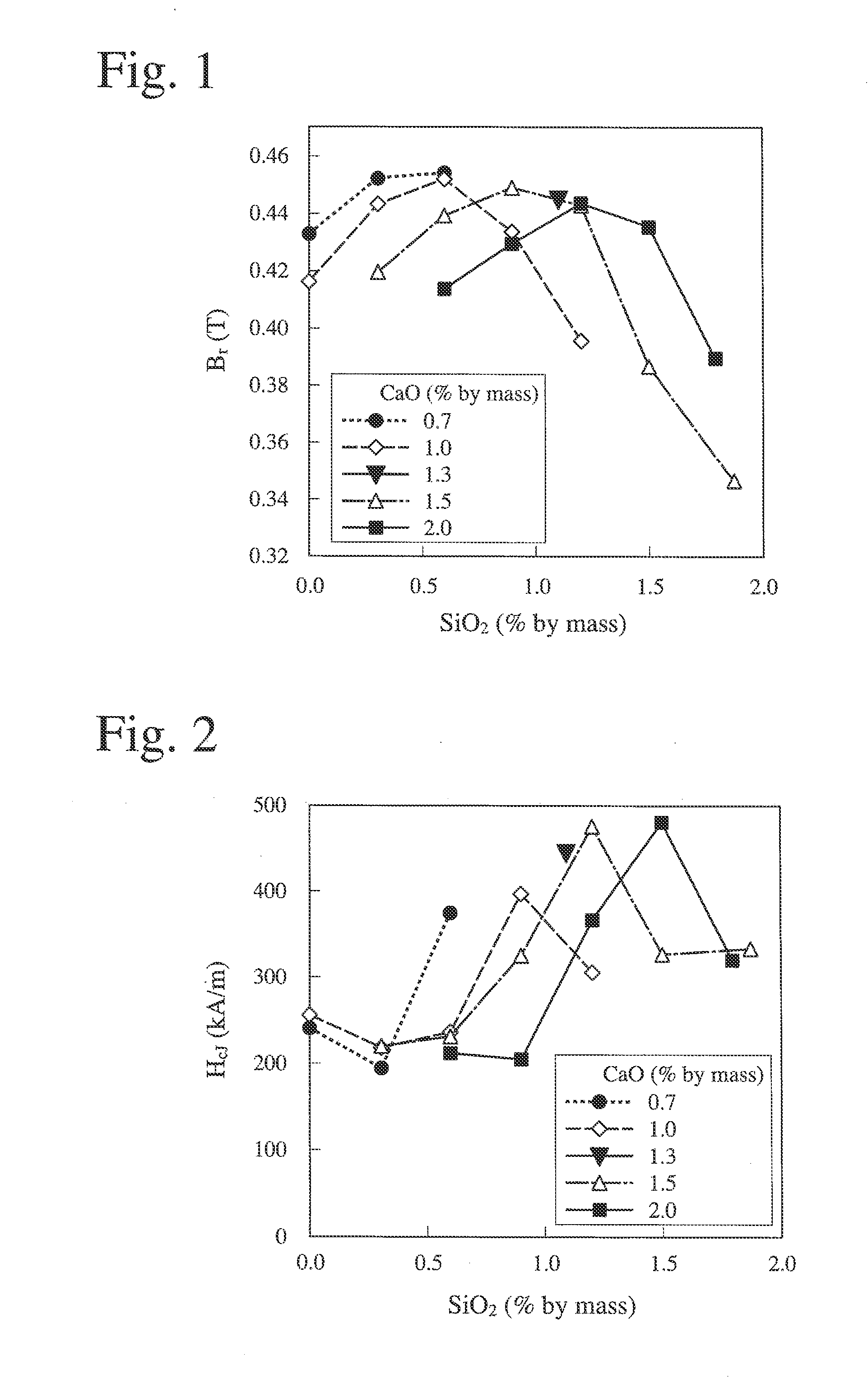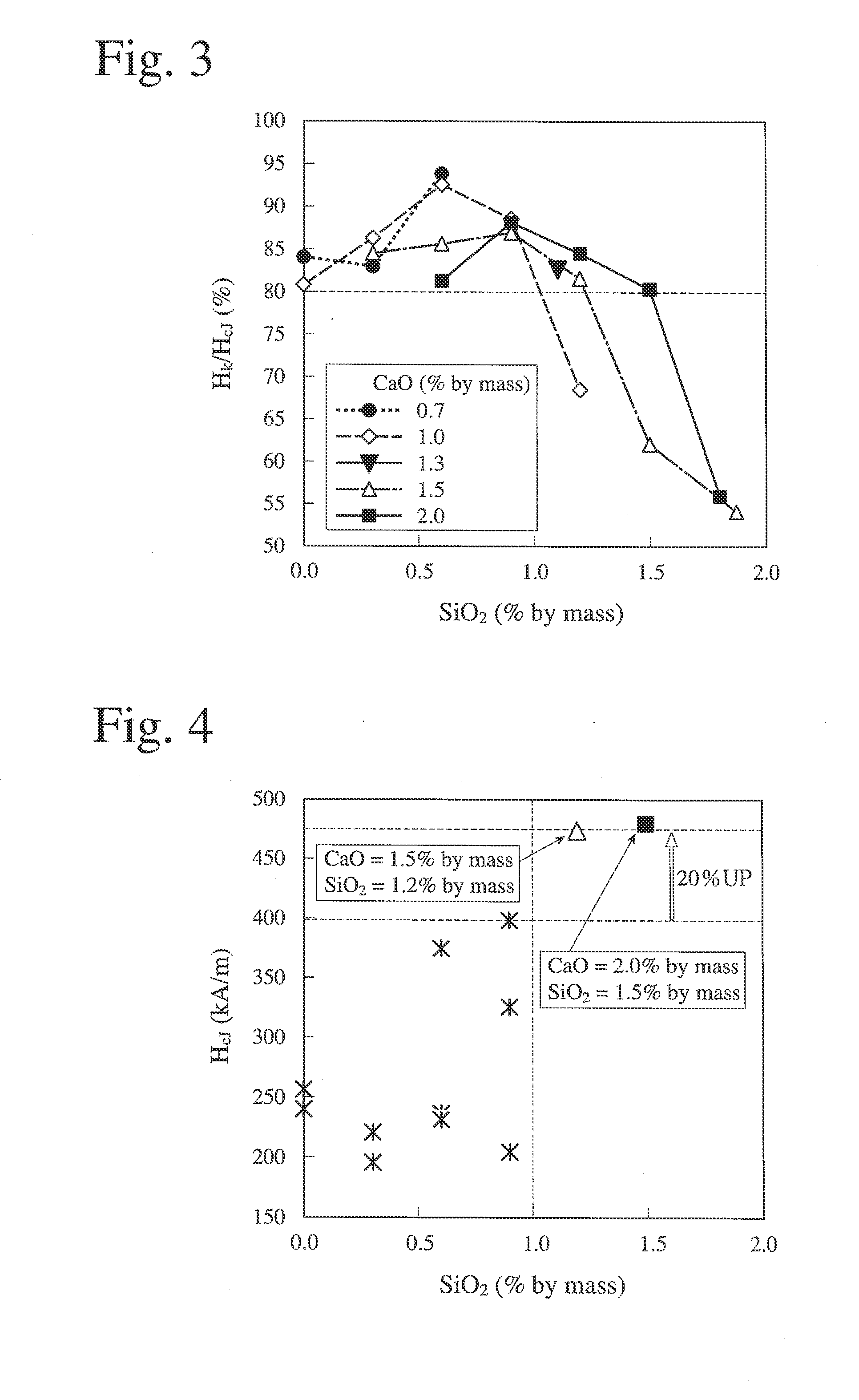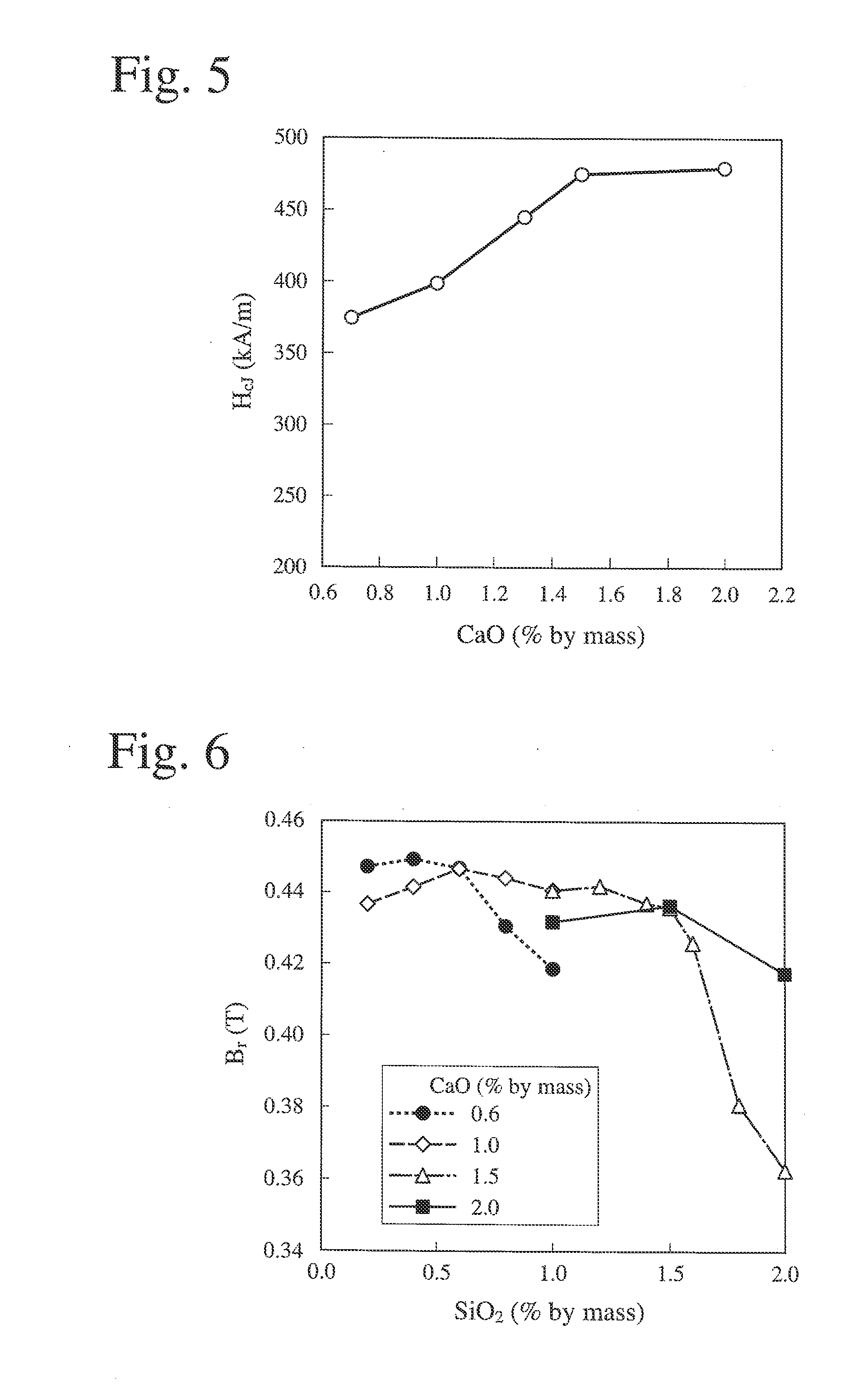Method for producing sintered ferrit magnet, and sintered ferrite magnet
a technology of ferrite magnets and ferrites, which is applied in the direction of magnets, magnetic materials, magnetic bodies, etc., can solve the problems of poor squareness ratio, insufficient high, and substantially the same level of magnetic properties, and achieve high br and squareness ratio hk/hcj, improve hcj, and improve the effect of hcj
- Summary
- Abstract
- Description
- Claims
- Application Information
AI Technical Summary
Benefits of technology
Problems solved by technology
Method used
Image
Examples
example 1
[0120]CaCO3 powder, La(OH)3 powder, Fe2O3 powder and CO3O4 powder were mixed to have the formula of Ca1-x-yLaxAyFe2n-zCOzO19-δ, wherein x=0.5, y=0, z=0.3, n=5.2, and 6≧0, and 0.1% by mass of H3BO3 powder was added to the total amount (100% by mass) of the mixed powders to produce a starting material powder. This starting material powder was mixed by a wet ball mill for 4 hours, and granulated by drying. It was calcined at 1300° C. for 3 hours in the air, and the calcined body was coarsely pulverized by a hammer mill to obtain coarse powder.
[0121]SiO2 powder and CaCO3 powder (calculated as CaO) were added in the amounts shown in Table 1 to the above coarse powder, and fine pulverization was conducted by a wet ball mill using water as a solvent until its average particle size (measured by an air permeation method) became 0.55 μm. Each of the resultant fine powder slurries was molded in a magnetic field of about 1.3 T under pressure of about 50 MPa with a compression direction parallel...
example 2
[0129]Sintered magnets were produced in the same manner as in Example 1, except that SiO2 powder and CaCO3 powder (calculated as CaO) were added in the amounts shown in Table 3 to a composition having the formula of Ca1-x-yLaxAyFe2n-zCOzO19-δ, wherein x=0.5, y=0, z=0.2, n=4.8, and δ≧0.
[0130]The sintered magnets were measured with respect to a residual magnetic flux density Br, coercivity HcJ, and a squareness ratio Hk / HcJ. The measurement results are shown in FIGS. 6-8. As in Example 1, in FIGS. 6-8, the axes of abscissas represent the amount (% by mass) of SiO2 added, and the axes of ordinates represent a residual magnetic flux density Br (T) (FIG. 6), coercivity HcJ (FIG. 7), and a squareness ratio Hk / HcJ (FIG. 8), data at the same CaO content being connected by a straight line.
TABLE 3SampleCaOSiO2No.(% by mass)(% by mass)CaO / SiO22010.60.23.002020.60.41.502030.60.61.002040.60.80.752050.61.00.602061.00.25.002071.00.42.502081.00.61.672091.00.81.252101.01.01.002111.51.01.50 212*1.51....
example 3
[0134]Sintered magnets were produced in the same manner as in Example 1, except that SiO2 powder and CaCO3 powder (calculated as CaO) were added in the amounts shown in Table 4 to a composition having the formula of Ca1-x-yLaxAyFe2n-zCOzO19-δ, wherein x=0.5, y=0, z=0.25, n=5.0, and δ≧0.
[0135]The sintered magnets were measured with respect to a residual magnetic flux density Br, coercivity HcJ, and a squareness ratio Hk / HcJ. The measurement results are shown in FIGS. 10-12. As in Example 1, in FIGS. 10-12, the axes of abscissas represent the amount (% by mass) of SiO2 added, and the axes of ordinates represent a residual magnetic flux density Br (T) (FIG. 10), coercivity HcJ (FIG. 11), and a squareness ratio Hk / HcJ (FIG. 12). To investigate influence by the Co content (z) in FIGS. 10-12, Samples 111-115 in Example 1 and Samples 211-217 in Example 2 were plotted, and data at the same Co content (z) were connected by a straight line.
TABLE 4SampleCaOSiO2No.(% by mass) (% by mass)CaO / SiO...
PUM
| Property | Measurement | Unit |
|---|---|---|
| Fraction | aaaaa | aaaaa |
| Percent by mass | aaaaa | aaaaa |
| Percent by mass | aaaaa | aaaaa |
Abstract
Description
Claims
Application Information
 Login to View More
Login to View More - R&D
- Intellectual Property
- Life Sciences
- Materials
- Tech Scout
- Unparalleled Data Quality
- Higher Quality Content
- 60% Fewer Hallucinations
Browse by: Latest US Patents, China's latest patents, Technical Efficacy Thesaurus, Application Domain, Technology Topic, Popular Technical Reports.
© 2025 PatSnap. All rights reserved.Legal|Privacy policy|Modern Slavery Act Transparency Statement|Sitemap|About US| Contact US: help@patsnap.com



